 |
 |
SAKUNTALAM makes
history at the 15th Kutiyattom Festival
February 2, 2002 |
| It
was an event in the history of Koodiyaattom. An event that never occurred
within a span of 2 centuries, according to Venu.G, the director, Natanakairali,
Ammannur Chachu Chakkyar Gurukulam, Irinjalakkuda, Kerala. A full drama,
Sakunthalam, with the ‘Soothradhara-Pravesa’ and ending with “Bharathavakyam”
was presented at Natanakairali during the first week of January at the
traditionally constructed small naatyagriha, at Natanakairali. ‘Bharathavakyam’
is the ritualistic completion of a play. This event is permitted, only
if a full play commencing with a poorvaranga is presented. The existing
plays were too long and for 2 centuries none dared to present one, essentially
for want of time and money.
The Chakyars (the community bestowed with the rights to present Koodiyaattom) did not attempt this play in Sanskrit, which is a priceless work of Kalidasa. The legendary reason attributed was that a Chakyar, in this play, tried to look at a tree and a deer together and his eyes became frozen. The technical reason often quoted was the lack of a production manual and an acting manual. Venu rejected the first one with due respect. Is the lack of supporting manuals a valid reason for not attempting a play like Sakunthalam? Venu said, no. Thus two years back, the young enthusiasts, who were trained in the gurukulam lined up with Venu and scholars, like Dr. Narayana Pisharoti (Teacher and Sanskrit scholar who has translated Bharata’s Natyasastra into Malayalam) and Prof. Dr. K.G. Poulose (Principal of the Govt. Sanskrit College Tripunithura, Kochi) and prepared the needed manuals. Blessed by the veteran Padmashri. Ammannur Madhava Chakyar, the kulagurau, rehearsals began. The play was presented in 7 acts through four days; three to four hours a day. It is to be underlined that Natanakairali had begun this endeavour 2 years earlier to the UNESCO’s acceptance of Koodiyaattom, in 2001, as an art form to be preserved due to its heritage and socio-cultural values. It was an experience that one could rarely have in one’s lifetime. i.e. to witness a full play from the Sootradhara-Pravesam to Bharathavakyam. Necessary text editing was done to avoid undue dragging that does nothing other than waste time and thrill the very thin population of Koodiyaattom exponents. However, the four late evenings were moments of dynamic meditation to the artists as well as the audience. It is just impossible to delineate the experience in written or spoken words. Elite readers of Narthaki need no description of the play, Sakuthalam or an introduction to the great poet Kalidasa. The entire story spins around the ‘love at first sight’ between king Dushyanta and Sakunthala, the beautiful maiden of sage Kannua’s hermitage. There is enough and more for the actresses to score over the males. Probably this is another reason why the male dominated theatre did not entertain this play during the recent centuries. However, the legend about the Chakyar who lost his eyesight indicates that this play was presented sometime in the far off past. All these lead any earnest, unbiased theatre lover to applaud Natanakairali, for its very successful and daring attempt, very much within the precincts of Ammannur Gurukulam. It was a gracious gesture that the traditionalist in the Gurukulam too, finally approved of the presentation. Kapila as Sakunthala and Sooraj Nambiar as Dushyantha were remarkable. The audience could feel the admixture of the royal and the divine characters and deeds, which otherwise remained as personal images within those who loved to read Kalidasa. Kapila, small in stature, worked out Sakunthala with commendable ease. A pair of talking eyes did the major work; an asset indispensable to a Koodiyaattom artist. Though with a relatively sharp voice-timbre, Kapila showed merely detectable strain in her verbal rendering. Ammannur Rajanish as Naandi-Sutradhara, Sharngarava, Fisherman, and Matali showed his versatile mastery over the techniques of mukha-abhinaya and also vachica. Ranjith Ramachandran as Suthradhara, Senapathi, Policeman and Kanva was noted for his powerful voice and rendering style. With a physique that suited and befitted the characters allotted to him, Ranjith had an upper hand in the scenes he was involved in. |
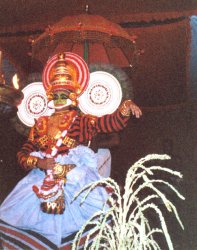 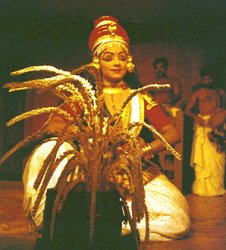  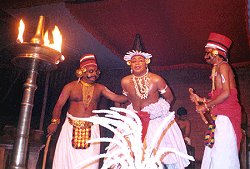 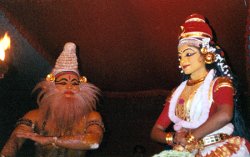  |
| Tomoe Tara
Irino who presented the Nati, Aparna Nangiar and Sarita T R, who enacted
Priyamvada and Anasuya were simply marvelous. The ease with which they
just accommodated each of the major characters revealed how they have internalized
the poet’s vision and the acting techniques.
The only veteran in the play was Ammannur Kuttan Chakyar, who handled the sootradhara in the traditional style. It was evident that the maestro had to assert his ground with due seriousness – the youngsters could not be taken for granted. Kalamandalam Rajeev, Kalamandalam Hariharan and Narayanan Nambiar on the Mizhavu and Panchamukha-Mizhavu facilitated with the percussion-voice, the needed tone for every bit of acting. Panchamukha-Mizhavu is a forgotten percussion unit that has not been on the stage for a very long time. V.K. Hariharan deserves due credits for its near resurrection. The scenes in which chariots, hoses etc. were a part of the nirjjeeva-aaharya, this wonderful percussion unit compensated their realistic absence so well that one could feel them present in huge dimensions. Kalanilayam Unnikrishnan and P. Nandakumar on the Edakka with their dexterous rolls on the percussion-skin provided the needed music too. Kalamandalam Jayaprakash, a gradate Kathakali vocalist proved his recognizable mastery in using kurumkuzhal, a wind instrument that normally is restricted to accompany the percussion ensembles in temples. He showed and made the audience feel that the short equipment can produce the needed notes, good enough to recognize the ragas. Kalamandalam Ram Mohan, the veteran Make-up and costume expert agreed that the costumes and make-up has to be designed with a new vision, to fit it within the costume-concepts in Koodiyaattom. Ramankutty Achari’s expertise in carving the wooden ornaments needed no special reference, for, the characters would not have achieved their shapes, but for the glittering rich ornaments. The 4 day long ‘Sakunthalam’ play was not just a visual treat. The forenoon sessions were a lot for the theatre and media brains, from five other nations too. In the small village, Irinjalakkuda, this great historic event was a part of the 15th Kutiyattom Festival. But the absence of Koodiyaattom experts, from other parts of Kerala, has been an undoubted index to the fact that the performers, even youngsters, need some extraneous agency to unlock their possessive and dogmatic thought patterns. May be, UNESCO’s statement that Koodiyaattom is a “Masterpiece of the Oral and Intangible Heritage of Humanity” should work out the process. |
| C P Unnikrishnan is a Kochi based Kathakali actor, critic and research scholar engaged at present in tracing the interlinks among the art forms of Kerala based on Bharatha's Natyasasthra. | 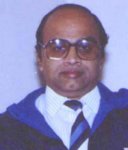 |